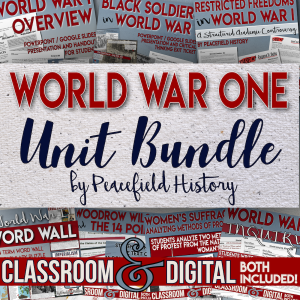Description
This lesson provides an overview of World War I from the U.S. perspective at a level meant for middle school students. Topics include militarism, imperialism, alliances, and nationalism (as they relate to WWI, a comparison of map of Europe before and after the war, wartime propaganda, trench warfare, the events that led the U.S. into the war, different groups involved with the war (including Native Americans, women, immigrants and Black Americans, the war on the homefront, and the ending of the war. Teachers can utilize this in combination with the World War I inquiry from Peacefield History or as a standalone resource. You can view more in the preview here – World War I Overview – Preview.
At first glimpse, it might appear as those there is a lot of direct instruction. However, most of these days include sections for self-directed learning or cooperative learning. Although this resource is intended for middle school students, it can also work with high school students who might need remediation.
Included in this resource:
- A 10-page handout for students with questions included (and answer key)
- A version of the handout without the questions included (if students answer questions digitally)
- A 60 slide Google slideshow with linked videos, maps exercises, primary source analysis, and interactive and cooperative learning. – There are two versions included. The first is for classroom use and the second is for students to answer the questions digitally. The presentation is Pear Deck compatible.
- 2 versions of a quiz that covers the first half of the overview
This resource specifically addresses the following NYS standards:
8.4a – European militarism, the alliance system, imperialism, and nationalism were all factors that contributed to the start of World War I.
8.4b – International, economic, and military developments swayed opinion in favor of the United States siding with the Allies and entering World War I. Domestic responses to World War I limited civil liberties within the United States.
- Students will examine an overview of the causes of World War I, focusing on the factors leading to the United States entry into the war.
- Students will examine examples of war propaganda and its effects on support for the United States involvement in the war.
- Students will examine the restrictions placed on citizens after the United States entry into the war, including the Espionage Act (1917) and the Sedition Act (1918).
8.4c – New military technologies changed military strategy in World War I and resulted in an unprecedented number of casualties.
- Students will examine the effects of the changes in military technologies used during World War I, including trench warfare, chemical weapons, machine guns, and aircraft.
8.4d – Following extensive political debate, the United States refused to ratify the Treaty of Versailles. The United States then sought to return to pre-war policies by focusing on domestic rather than international matters.
© Copyright 2022 Peacefield History. All rights reserved. Permission is granted to copy pages specifically designed for student or teacher use by the original purchaser or licensee. This is intended to be used by one teacher unless additional licenses have been purchased. The reproduction of any other part of this product is strictly prohibited. Copying any part of this product and placing it on the Internet in any form besides Google Classroom is strictly forbidden. Doing so makes it possible for an Internet search to make the document available on the Internet, free of charge, and is a violation of the Digital Millennium Copyright Act (DMCA).






Reviews
There are no reviews yet.